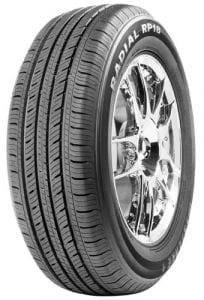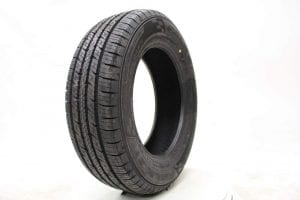The Best Car Tires
We looked at the top 7 Car Tires and dug through the reviews from 29 of the most popular review sites including and more. The result is a ranking of the best Car Tires.

Our Review Process
Don't Waste Your Money is focused on helping you make the best purchasing decision. Our team of experts spends hundreds of hours analyzing, testing, and researching products so you don't have to. Learn more.
Our Picks For The Top Car Tires
The Westlake RP18 boasts a design that can handle wet roads with confidence. It has a high speed rating, especially for a tire in its price range. Durability is also a plus.
Durable TiresDurable tires that can handle wet roads with ease.
Good handling is a hallmark of the General AltiMAX RT43. The tire keeps its grip in nearly all conditions, with a well-cushioned ride throughout. And with a 70,000 mile treadlife warranty, it also boasts durability.
Grippy TiresGrippy tires that can handle all sorts of road conditions and terrain.
Buying Guide
No matter how well you take care of your car, how often you inspect it or how regularly you change the oil, there’s one part that’s going to need to be replaced regularly: The tires.
Hop from a car with old tires into a ride with new ones, and you’ll instantly feel the difference. It might be the most important safety feature on any automobile, so before you slap on that cheap replacement set, there’s a few things to consider. Putting the proper tires on your car will ensure that the speedometer is accurate and the transmission doesn’t take any loads it can’t handle — not to mention the peace of mind that comes with healthy, road-gripping wheels.
First and foremost, let’s answer the question: Do you need a new set of tires at all? Most buyers replace their tires on one of two occasions: When they get a flat or when a mechanic tells them they need it. While you’ll certainly be able to sense the change in handling as your tires lose their tread, there’s a number of easy visual cues that can alert you when your tires are on their way out.
Most modern tires come equipped with tread wear indicators. While the exact placement of the indicators can vary, they should be fairly obvious. Just look for tiny bars in the grooves of your tread, running perpendicular to the tread pattern. In a new or slightly used tire, they should be well beneath the top of the tread. Once they are flush with the outer surface of the tread, it’s definitely time to replace the tire.
Failing that, there’s an old fashioned trick to test the depth of your tread, and therefore the wear and tear on your tire. Take a penny or quarter and insert it into the deepest tread you can find on your tire, making sure to align it in such a way that you’re dipping Abe Lincoln (or George Washington) into the canyon headfirst. If you can still see the top of their head, it’s time to go tire shopping.
Newer cars can back all this up by alerting you to changes in tire pressure, but there’s still good reason to periodically check the tread up close and personal. The way your tread is worn can even be a red flag for alignment or inflation issues. Is the tread worn more on one side of the tire than the other? Get your alignment checked. Is there more wear on the shoulders (outer edges) of the tire versus the center? Your tire might be underinflated. Losing tread on the center but not the shoulders? It could be overinflated.
Once it’s time to buy a tire, you’ll find an intimidating amount of options out there. The first thing to do is take a look at your old tires. You may not want to stick with the exact type or brand as your old wheels, and that’s fine — especially if they didn’t serve you well. But you should at least get a tire with the same size and speed rating as your car’s original set. And that’s the original set, mind you — which might not necessarily be the last set of tires you had.
How do you find the size and speed rating? Look on the driver’s side doorjamb. There should be a sticker there with all the specs on your factory set of tires. Finding the numbers on a tire is a bit more complicated, but relatively easy if you know what you’re looking for. On the sidewall of any tire, you’ll find a set of numbers. To get the size, look for a prominent set of numbers and letters separated by a slash. (That’s a “/” symbol, mind you. If there’s an actual slash, maybe find another tire.) That set of characters is the size: The first letter represents the general tire type (“P” for passenger, perhaps), while the first set of numbers before the slash is the tire width in millimeters. After the slash, you’ll find another number representing the aspect ratio, then a letter that tells you what construction the tire is (“R” for radial, “B” for belted bias and “D” for diagonal bias). The number after that letter is the diameter of the wheel rim.
After all that, you should see another two or three-digit number followed by a letter. The number is your load index, a number that’s used to measure your tire’s maximum carrying capacity. The letter is your speed rating. It’s a code you can easily look up elsewhere, but in general: The higher the letter is in the alphabet, the more speed your tires can handle on a consistent basis. (Except for the “H” rating, which is somewhere in the high middle of typical tire ratings.)
If you’re feeling dizzy in the face of all that jargon, don’t feel like you need to translate it. Just remember these are the numbers you’ll need to match up from your original tires to your new ones.
Aside from the measurements, there are a vast array of tire styles to choose from. All-season tires like the Westlake RP18 are a popular, all-around choice. While not the pinnacle in terms of grip or handling, they’re more than capable for most commutes and they’ll keep that grip in rain or light snow. Performance tires are typically marketed to sports cars, with their higher handling and speed rating balanced out by a shorter tread life. Snow tires, as you might expect, are deeply grooved to handle heavy winter conditions, while summer or “three-season” tires are built for a speedier ride in either rain or sunny weather.
Why we recommend these car tires?
Products Considered
Products Analyzed
Expert Reviews Included
User Opinions Analyzed
Our experts reviewed the top 7 Car Tires and also dug through the reviews from 29 of the most popular review sites including and more. The result is a ranking of the best of the best Car Tires.
DWYM is your trusted roduct review source. Our team reviews thousands of product reviews from the trusted top experts and combines them into one easy-to-understand score. Learn more.
The Best Bang For Your Buck
General AltiMAX RT43 Radial Tire – 195/65R15 91T
Key Takeawy
Good handling is a hallmark of the General AltiMAX RT43. The tire keeps its grip in nearly all conditions, with a well-cushioned ride throughout. And with a 70,000 mile treadlife warranty, it also boasts durability.
What other experts liked
What other experts didn't like
What to Look For
- Many modern cars have electronic alerts that tell their drivers when the air pressure is low in a certain tire. Even with that backup, it’s good to check their air pressure every month. It’s important to keep them inflated to the correct amount, and you can find that air pressure rating in your driver’s manual or the sticker on your driver’s side doorjamb. Make sure you use that number and not the air pressure listed on the sidewall of your current tire. That number is usually the maximum amount of air pressure, not the recommended amount.
- There’s a myriad of numbers and letters on the sidewall of your tire other than the size. Some of them, such as the load index, are good to know. Others, such as the UTQG (Uniform Tire Quality Grading), sound important but aren’t that vital. The UTQG is a rating system for treadwear, traction and temperature that was originally established in the 1970s by the National Highway Traffic Safety Administration. However, the tests that determine the ratings are often conducted by the manufacturers themselves, and there’s plenty of wiggle room in the methodology that allows the numbers to be fudged. So even if these ratings were easy to compare between tires (and they’re not), they should taken with a grain of salt.
- One number you should pay attention to — especially on used tires — is the manufacture date. Even if tires have gone completely unused, deterioration in the material will happen over time — the same way you’ll see cracks appear in old rubber bands when stretched. Even completely new tires can start to wear down after five years or so, and that process accelerates in warmer climates. Never buy tires over 10 years old and, in the unlikely event yours are still rolling after that time, have them replaced immediately.
- Tire warranties can provide some pleasant peace of mind for buyers. And if it’s a bad warranty, that peace of mind will last right up until the tire has a problem. Pay particular attention to the type of warranty on a tire. Treadwear warranties might give you a ballpark idea of how long a tire is expected to last, but you can typically only hope to get a partial refund — which must apply to the cost of a replacement tire that’s the same brand and model. Road hazard warranties, as the name implies, will usually cover more than just wear and tear, including incidental flat tires and maybe even roadside assistance. Read the fine print, though: A particular tire shop or mechanic often offers such warranties, and the warranty might only be redeemable if you’re near that shop.
More to Explore
The earliest wheeled vehicles found date back to early Mesopotamia, and they ran on tires of leather. If that sounds like a bumpy ride, consider that the “improvements” in tire tech over the next few centuries focused on durability, not comfort. The standard construction for a wagon wheel was steel-shod wood until soon after the advent of the automobile in the 1800s.
The biggest tiremaker in the world isn’t Michelin or Goodyear or Dunlop. In fact, they don’t make any tires that would fit your car at all … unless it’s a few inches wide and made of plastic. LEGO is the world’s leading manufacturer of tires by a wide margin, putting out over 300 million tiny ones a year.


















